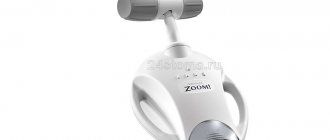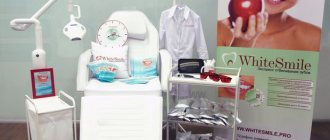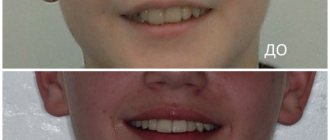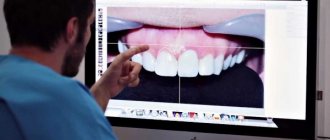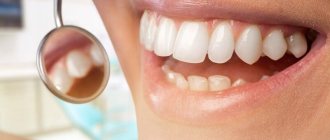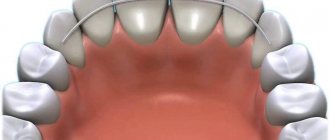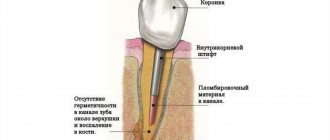A gummy smile is a serious aesthetic defect. When a person smiles, the upper gum is visible to others - it looks ugly. Not everyone succeeds in “relearning” so that their smile becomes more closed, so many people are forced to put up with this shortcoming all their lives. Fortunately, there are modern cosmetic correction methods. Sign up for a gummy smile treatment at the BL clinic - and you will smile more often!
Causes of gummy smiles in children and adults
In adults, a gummy smile is quite rare, since this problem in most cases appears in childhood. There are several known main reasons for the appearance of this problem: improper development of the facial skeleton, a short upper lip that cannot cover the gum, or, on the contrary, an overly large gum that covers the upper row of teeth more than necessary. At the same time, a strongly pronounced gummy smile, as a rule, is a consequence of malocclusion, or anomalies in the development of the maxillofacial skeleton.
Gingivitis or Periodontitis
Treatment of periodontitis and gingivitis with laser is the most effective treatment method today.
The beam action very precisely and effectively cleanses periodontal pockets, achieving sterility that cannot be achieved with mechanical cleansing and rinsing. The treatment is aimed at the cause of the disease - pathogenic flora, which occurs primarily due to improper daily cleansing. Already after the first procedure, patients notice that bleeding and inflammation of the gums have decreased, and the pain during chewing has gone away.
Reconstructive surgery in the treatment of gummy smiles
In situations where a gummy smile appears as a result of abnormal development of the facial skeleton, the only effective solution to the problem is surgery. For these purposes, osteotomy (correction of the upper jaw) and ostectomy (operation performed to correct the lower jaw) are used.
In the vast majority of cases, such surgical interventions are carried out in the presence of serious anomalies in the development of the bite, but can also be performed in the normal position of the jaws, for example, to correct a gummy smile.
What is a gummy smile?
According to statistical studies, the pathology in question is observed in 10-15% of people. A gummy smile refers to the uncontrolled exposure of an area of gum tissue that occurs during a person’s natural facial reaction. A strip of tissue placed between the upper edge of the frontal incisors and the lower line of the lip creates a repulsive effect, since the aesthetic standard is a smile in which only the upper incisors are exposed, and the lower part of the dentition is barely noticeable.
Immunogenicity
Immunological complications during botulinum therapy are reduced to acute allergic reactions to human serum albumin. This phenomenon is possible when too high doses of the toxin are administered, which leads to the formation of IgH antibodies, the number of which increases in direct proportion to the volume of the administered BTA drug. The result of this reaction of the body is inactivation of the toxin. However, in aesthetic medicine, BTA preparations are usually used in very small doses, so the issue of immunogenicity is not a cause for concern.
Preparing for gum surgery
Diagnostics
Any operation is planned based on the results of the examination. In order to choose the right method for gum correction, the periodontist conducts a visual and instrumental examination. Computed tomography allows you to obtain more detailed information about the condition of the jaw structures.
Sanitation of the oral cavity
An important point before surgery is to ensure aseptic conditions in the oral cavity to avoid infection. Therefore, before the operation, sanitation (removal of caries, removal of diseased teeth that cannot be treated) and professional hygiene are required.
Excluding the causes of the disease
If a patient is diagnosed with bite problems, consultation and treatment with an orthodontist may be required, since these pathologies are one of the main causes of gum disease.
If the gingival contour is disrupted due to a traumatic factor with crowns or dentures, it is necessary to replace the orthopedic structures.
Platysma bands
Age-related skin changes are associated with excessive laxity of the skin, loss of elasticity, formation of a double chin, lipodystrophy, prolapse of the submandibular glands and bone resorption. The subcutaneous muscle of the neck can become overactive, lose tone, or disintegrate, all of which leads to the so-called “turkey neck” effect. Platysma bundles located horizontally and vertically become noticeable with increased contraction.
Botulinum therapy in the neck area is aimed at reducing the external manifestations of platysma contraction. In addition, relaxation of the platysma bands has a positive cosmetic effect on the oval line and wrinkles from the corners of the lips to the chin. The best candidates for botulinum toxin therapy in the neck area are patients who demonstrate active contraction of the platysma during conversation.
BTA preparations are administered to the patient in a sitting position with maximum tension of the platysma in the direction of the cords. Depending on the length of the cord, the BTA is inserted into 4-8 points located at a distance of 1.5 cm from each other, grasping the cords with the non-dominant hand (Figure 16)
.
Figure 16. BTA injection points for correction of age-related changes in the neck.
The moderate initial recommended dose is 2 units. Botox® or 5 units. Dysport® for every point. Too deep administration and overdose should be avoided.
Complications: Often, after injections of BTA drugs into the neck area, bruises remain. It is recommended to avoid injecting BTA into the pharynx due to the risk of exposure of the underlying muscles to the toxin, which can lead to difficulty swallowing, weakening of the neck and dysphonia. Botulinum therapy is also not suitable for correcting horizontal wrinkles on the neck. In addition, due to the large number of injection points for BTA drugs, the anti-aging neck correction procedure is quite expensive.
Comment by cosmetologist, dermatovenereologist Ya. A. Yutskovskaya:
— To date, some experience has been accumulated and there are published data on botulinum therapy for horizontal neck wrinkles. Correction of this area, of course, requires a combination of botulinum therapy and injection plastic surgery using the most flexible and easily sculpted fillers. BTA injections as monotherapy are not always effective. The total dose of Dysport for the correction of neck wrinkles is 50-60 units. Botulinum toxin is injected along the wrinkle at points located 5 mm above it, at intervals of approximately 1 cm. As a rule, the drug in standard dilution is additionally diluted 2 times with saline solution.
Correction methods
Technologies used in aesthetic dentistry provide several ways to solve the problem of a gummy smile. The choice of an appropriate technique is determined by the factors acting as the root cause of the anomaly. Surgical and orthodontic treatment methods are used, and in case of complex forms of development, complex restoration of the maxillofacial region, which involves a number of cosmetic procedures.
Increased lip volume
One of the options to eliminate the defect is the procedure for increasing the volume of the upper lip. To achieve the desired result, a gel is used, the use of which not only increases the size, but also reduces the mobility of the facial area. Practice shows that the achieved effect allows you to hide the gum line.
Botox correction
A popular technique, the popularity of which is determined by the effect that occurs after a Botox injection. The injection, carried out in the area of the nasolabial folds, leads to fixation of the position of the upper lip, which is why it remains motionless during a smile.
Frenum plastic surgery
Surgery aimed at changing the structure of the frenulum is considered the safest of all options associated with tissue plastic surgery. The correction, carried out by excision of a section of tissue connecting the gum part and the inner area of the lip, allows you to increase the length to a level sufficient to eliminate the aesthetic defect.
Suturing the orbicularis oris muscle
In situations where the factor causing the appearance of a gummy smile is the hyperactivity of the orbicularis muscle surrounding the mouth, surgery is prescribed. The suturing procedure involves cutting the tissue under the lip along the incisor line, allowing access to the muscle structure. After adjusting the muscle and mucosa, the doctor repositions the flap to give it a natural shape. The technique is radical in nature, but guarantees the achievement of the planned aesthetic indicators due to the growth of soft tissues and relaxation of overstrained muscles.
Plastic correction
Diagnosing hyperplasia necessitates laser correction. The procedure is safe and painless - the dentist removes excess tissue covering the vestibular surface of the teeth and forms an even contour.
Installation of braces
In situations where an aesthetic anomaly is associated with defects in the dentition, orthodontic treatment is prescribed - installation of braces. The corrective system has a targeted effect on problem units and returns them to their natural anatomical position. At the end of the correction course, the duration of which varies in the range of 6-18 months, the visual height of the gum tissue acquires the correct proportions.
tip of the nose
The tip of the nose is an important component of its aesthetic appeal. With age, the tip of the nose droops, which emphasizes the convexity of its back. Drooping of the nasal tip in young patients is associated with increased activity of the depressor septum muscle during smiling, which is also often accompanied by shortening of the upper lip. The same phenomenon is observed in those with a prominent nose and an underdeveloped chin.
Before deciding on the introduction of BTA, the length of the patient's upper lip and nasolabial angle is assessed. There are 2 ways to administer injections into the depressing septum nasal muscle: percutaneous and intraoral. The latter method is quite difficult to implement, so we will only consider the method of administering BTA through the skin.
Due to the special sensitivity of the nose to external anesthetics, it is recommended to use ice compresses to reduce pain. BTA insertion points are located on both sides of the nasal septum at the base of the medial crus (Figure 12)
.
The BTA drug is administered superficially in a dosage of 1-2 units. Botox® or 4-6 units. Dysport® for every point. Dosage may vary depending on the desired degree and duration of correction, facial proportions, observed muscle activity and the work of adjacent muscles.
Figure 12. BTA injection points for correction of drooping nasal tip
Complications: In general, complications when correcting drooping nasal tip with BTA preparations are extremely rare. Among the side effects, patients most often name pain. Too much action of toxins on the depressor septum nasalis muscle can lead to ptosis of the upper lip.


